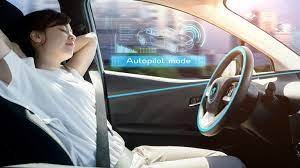
1. Self-driving cars We’ve all known about autopilot in planes for many years and it hasn’t put us off flying, but a car that drives itself? What about all the opposite cars that don’t? There could be a couple of wrinkles to iron call at that respect but it’s been conclusively demonstrated that the self-drive car can and does work. The technology required to form this a day-to-day reality is already here, with radars and cameras assisting in reading the road and self-parking, while systems like Autonomous Emergency Braking show just how far we’ve come towards transferring driving responsibility from the human driver to the car itself. Now a gaggle of leading self-driving experts has created a startup company, Aurora Innovation, to assist create driverless vehicles for the masses. Building on the recognition of the concept and a few arguably successful tests round the world (such like Google’s Waymo), this company put such an exciting proposal forward to require the thought to subsequent level that it soon landed partnerships with vehicle manufacturing giants Volkswagen and Hyundai. Thanks to its collaboration with Aurora, Volkswagen is now so confident within the technology that it recently stated its aim to release commercial fleets of driverless vehicles in up to 5 cities round the world from as soon as 2021. It’s an opportunity that would not only signal an evolution in fleet management, but change how society functions forever.

2. Edge Computing Edge computing may be a distributed computing paradigm that brings computation and data storage closer to the situation where it's needed to enhance response times and save bandwidth. it's a topology instead of a technology.Data is that the lifeblood of recent business, providing valuable business insight and supporting real-time control over critical business processes and operations. Today's businesses are awash in an ocean of knowledge , and large amounts of knowledge are often routinely collected from sensors and IoT devices operating in real time from remote locations and inhospitable operating environments almost anywhere within the world.
But this virtual flood of knowledge is additionally changing the way businesses handle computing. the normal computing paradigm built on a centralized data center and everyday internet isn't compatible to moving endlessly growing rivers of real-world data. Bandwidth limitations, latency issues and unpredictable network disruptions can all conspire to impair such efforts. Businesses are responding to those data challenges through the utilization of edge computing architecture.
In simplest terms, edge computing moves some portion of storage and compute resources out of the central data center and closer to the source of the info itself. instead of transmitting data to a central data center for processing and analysis, that employment is instead performed where the info is really generated -- whether that's a mercantile establishment , a factory floor, a sprawling utility or across a sensible city. Only the results of that computing work on the sting , like real-time business insights, equipment maintenance predictions or other actionable answers, is shipped back to the most data center for review and other human interactions.

3. Drones Unmanned vehicles aren’t a replacement concept – their use was being investigated as far back because the First war . Yet it's only recently that these ‘drones’ have leapt from futuristic works of fiction depicted in sci-fi movies to being accepted and adopted across different industries and even sold for personal use. As with numerous technological innovations, the military pioneered the utilization of drones, using unmanned aircraft for reconnaissance and targeting over dangerous areas. Their efficiency, flexibility and skill to travel where people can’t was quickly recognised and put to good use in other ways, like using them to hold thermal sensors in search and rescue operations. Drones have even enabled a replacement sort of science that has evolved from aerial archaeology (using aircraft to spot archaeological remains) into drone archaeology – a far cheaper and more accessible way of investigating and documenting our history from the air (particularly useful for an industry where budgets are tight but the rewards are priceless). Drones are now available for anybody to shop for and that we can expect to ascertain an explosion in their commercial use. Amazon has made no secret of its plans to deploy drones to form deliveries and there are many other innovative startups now securing funding to carve their own niche within the marketplace. Two such examples are Starship Technologies in London and Matternet in California, which are looking to make lightweight and low-cost drones for automated deliveries both ashore and within the air. Such is that the rising adoption of economic drones that it’s been suggested this industry will impact the American landscape to the tune of USD 82bn and help create 100,000 jobs by 2025.

4. 3D printing Who didn’t think this idea had to be a joke once they first heard it? A machine that would ‘print’ solid objects? How? Well, now we all know how and 3D printing (or additive manufacture, to offer it its technical name) is revolutionising many industries, led by forward-thinking companies that have taken a risk on the emerging technology and are now set to vary the planet . In architecture, companies like Apis Cor are showing the chances of rehousing people after a crisis by using 3D printing to construct the most structure of alittle house within 24 hours. Another architect, Patricia Andrasik, was also investigating the method in 2017 with a view to rapidly producing sustainable homes for refugees in Iraq. Healthcare is another area where 3D printing helps to open up new possibilities. it'll at some point enable patients to print out their own medication, in doses tailored far more specifically to their needs than the one-size-fits-all drugs dispensed through the present channels. Even more extraordinarily, work is underway to develop 3D printer tissues and organs for human transplant. Novax DMA and CEIT Biomedical Engineering have worked together to custom-design titanium surgical implants, to correct inherited deformities or conditions caused by injury or disease. Elsewhere, San Diego-based Organovo has been performing on a bio-printing process that would take cells from blood samples and switch them into a ‘printable bio-ink’, paving the way for the longer term of 3D printing whole organs. This printing of tissue samples also will help improve the R&D process and reduce the necessity for animal testing, while opening up the potential for personalised medicine.

5. AI (AI)
Artificial Intelligence, or AI, has already received tons of buzz within the past decade, but it continues to be one among the new technology trends because its notable effects on how we live, work and play are only within the early stages. AI is already known for its superiority in image and speech recognition, navigation apps, smartphone personal assistants, ride-sharing apps then far more .
Other than that AI are going to be used further to research interactions to work out underlying connections and insights, to assist predict demand for services like hospitals enabling authorities to form better decisions about resource utilization, and to detect the changing patterns of customer behaviour by analyzing data in near real-time, driving revenues and enhancing personalized experiences.
The AI market will grow to a $190 billion industry by 2025 with global spending on cognitive and AI systems reaching over $57 billion in 2021. With AI spreading its wings across sectors, new jobs are going to be created in development, programming, testing, support and maintenance, to call a couple of . On the opposite hand AI also offers a number of the very best salaries today starting from over $1,25,000 per annum (machine learning engineer) to $145,000 per annum (AI architect) - making it the highest new technology trend you want to be careful for!
Machine Learning the subset of AI, is additionally being deployed altogether sorts of industries, creating an enormous demand for skilled professionals. Forrester predicts AI, machine learning, and automation will create 9 percent of latest U.S. jobs by 2025, jobs including robot monitoring professionals, data scientists, automation specialists, and content curators, making it another new technology trend you want to confine mind too!
 )
)
6. Cryptocurrency A valid currency that doesn’t exist within the world probably didn’t sound too far-fetched 10 years ago. tons folks were already using electronic banking to manage our finances and paying for things by debit and mastercard , therefore the days of real, physical currency were already numbered. Yet few could have imagined just how big virtual currency would become over subsequent few years. Take Bitcoin, for instance . Developed by a sensible and innovative figure known only as (the alias) Satoshi Nakamoto, this first cryptocurrency was only created in 2009 and now has up to twenty million users (more than doubling them within the last half of 2017 alone). Its price, while famously volatile lately , peaked at slightly below USD 20,000 per coin at the top of 2017, and there have even been suggestions that it could reach as high as USD 1m, making its investors an enormous sum of cash . While there are other decentralised cryptocurrencies on the market, Bitcoin’s success is now such it's accepted by companies like Microsoft and Expedia, so what’s to prevent it becoming ubiquitous within the next few years?

7. Video on demand While a decade ago all the signs pointed to a digital future, not many of us would have foreseen just what proportion this might change the house entertainment landscape. No longer are we limited by our access to a television, a chunky disc player and therefore the physical recording. Our collections are now gathering dust, while we download or stream almost any film or television program ever made, watching it at a moment’s notice from anywhere we will hook up with the web , on any computer, laptop, tablet or phone we happen to possess on us. Amazon has become an industry leader during this field too, with its Prime service neatly tying into the delivery subscription we already had and giving us relatively cheap access to a variety of titles. But i might argue that Netflix is that the real success story here, having ditched its successful DVD rental business model (with an inventory of three .6 million subscribers) to launch a streaming service, initially just within the US in 2007 then the remainder of the planet over subsequent decade. As we all know, the danger paid off. Netflix tapped into (and then fed) the trend of providing streamable content for an increasingly digital generation. It now commands 117 million subscribers (adding 8 million within the half-moon of 2017 alone) and is revolutionising home entertainment further, because it disrupts the normal theatrical release market to bring films to consumers instantly (such because the international release deal for Annihilation and therefore the surprise release of The Cloverfield Paradox in early 2018).
@endingplagiarism this obviously looks like a plagiarized post as well. Original source: https://www.vz.ae/blog/risky-business-5-far-fetched-business-ideas-became-big-hits
Wednesday, June 9th, 2021.
#onepercent #venezuela #affable
Downvoting a post can decrease pending rewards and make it less visible. Common reasons:
Submit